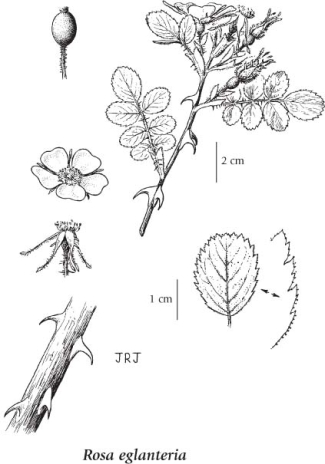sweetbrier
Rosaceae (Rose family)
Introduction to Vascular Plants
Map click to expand contents
Distribution of Rosa rubiginosa var. rubiginosa
Click here to view the full interactive map and legend
Species Information click to expand contents
General:
Medium to tall shrub, 1 to 3 m tall, usually thicket-forming; stems erect, armed with scattered, flattened, unequal, curved or hooked spines, sometimes also with short straight prickles; mature stems olive-green.
Leaves:
Alternate, deciduous, odd-pinnately compound, the axis fine-prickly and densely glandular; leaflets 5 or 7, broadly elliptic to nearly circular, 1-2.5 cm long, hairy and stalked-glandular beneath, coarsely double-saw-toothed, the teeth gland-tipped; leaves aromatic, especially in warm weather.
Flowers:
Inflorescence of 1 to 3 or more stalked flowers at the end of a lateral branchlet, the stalks glandular-hairy; corollas pink, saucer-shaped, 3-5 cm across, the petals 5, 10-20 mm long; calyces 5-lobed, the lobes 10-20 mm long, stalked-glandular, some of them with narrow, toothed lateral segments, spreading to reflexed after flowering, falling off when the fruit is mature; ovaries superior but enclosed in the urn-shaped floral tube (hypanthium); stamens numerous.
Fruits:
Achenes, enclosed by the fleshy hypanthium, which ripens into a scarlet, globe- to egg-shaped hip 1-1.5 cm long.
Illustration click to expand contents

If more than one illustration is available for a species (e.g., separate illustrations were provided for two subspecies) then links to the separate images will be provided below. Note that individual subspecies or varietal illustrations are not always available.
Illustration Source: The Illustrated Flora of British Columbia
Habitat and Range click to expand contents
Status Information click to expand contents
Synonyms click to expand contents
Synonyms and Alternate Names:
Rosa eglanteria L.
Taxonomic Keys click to expand contents
KEY TO ROSA
1. Stipules deeply fringed or comb-like; inflorescence multiflowered..........R. multiflora 1a. Prickles strongly curved, stout; calyx-lobes often with conspicuous lateral segments and usually reflexed after flowering.
2. Lower surface of leaflets stalked-glandular..............R. eglanteria 1a. Prickles not or slightly curved, often slender; calyx-lobes usually without lateral segments, usually ascending or erect after flowering.
3. Calyx-lobes deciduous in fruit, 12 mm long or less; petals 15 mm long or less...............R. gymnocarpa 4. Stems with well-defined infrastipular prickles (pair of prickles at or just below each node) or nearly unarmed.
5. Calyx-lobes usually glandular-bristly; leaflets finely toothed; plants from west of the Coast-Cascade Mountains............R. pisocarpa
6. Flowers small and clustered; calyx-lobes mostly 1-2 cm long and 2-3.5 mm wide at base; petals 1.2-2.5 cm long................R. woodsii 4. Stems more or less bristly with slender prickles; infrastipular prickles, if any, like the others.
7. Flowers mostly solitary, usually on lateral branchlets of current season; leaflets usually 5 to 7 (9); petals more than 2 cm long..................R. acicularis Source: Illustrated Flora of British Columbia (Vol. 4). (1999) |